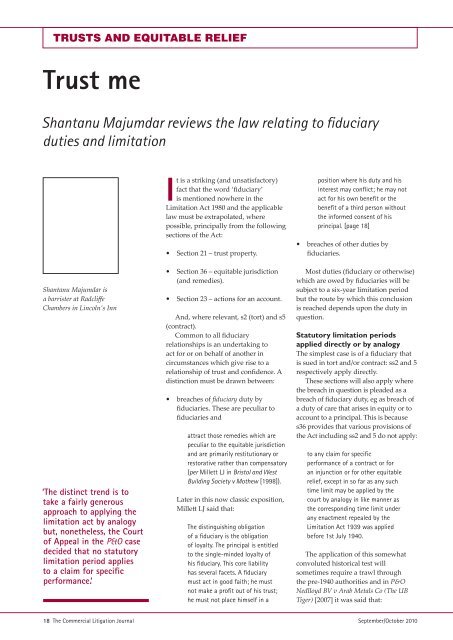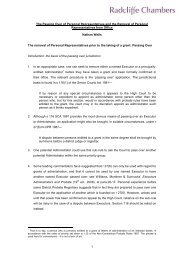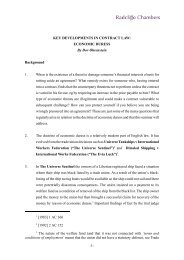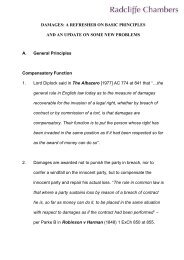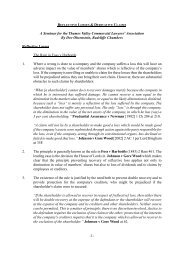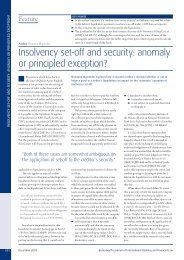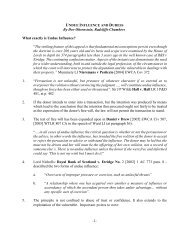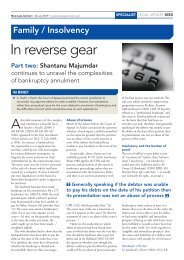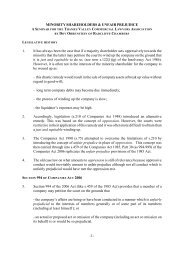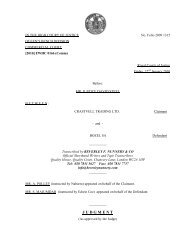You also want an ePaper? Increase the reach of your titles
YUMPU automatically turns print PDFs into web optimized ePapers that Google loves.
TRUSTS AND EQUITABLE RELIEF… if a statutory limitation provision,properly interpreted, applies to theclaim under consideration, equity willapply it in obedience to the statute, asindeed it must. However, even if thelimitation period does not apply becausethe claim is for an exclusively equitableremedy, the court will nonetheless applyit by analogy if the remedy in equity is‘correspondent to the remedy at law’.In other words, where the suit in equitycorresponds with an action at law acourt of equity adopts the statutoryrule as its own rule of procedure. (PerMoore-Bick LJ [at para 38])This question of correspondence hasbeen examined in a number of othermodern cases. In particular, in Coulthardv Disco Mix Club Ltd [1999] the claimantsought to rely on s36 in order to defeat alimitation defence by claiming damagesfor alleged breaches of fiduciary dutyin respect of under-accounting but itwas held that no distinction so far aslimitation was concerned could be madebetween an action for damages for fraudat common law and its counterpart inequity on the same facts.This decision was applied in Ciade Seguros Imperio v Heath (REBX)Ltd [1999] where common lawclaims for breaches of contract andduty were held to be based on preciselythe same factual allegations as aconcurrent claim for dishonest breachof fiduciary duty even though thelatter also involved an allegation ofintention.The distinct trend is to take afairly generous approach to applyingthe limitation act by analogy but,nonetheless, the Court of Appeal inthe P&O case decided that nostatutory limitation period appliesto a claim for specific performance(see Majumdar The Burden of HistoryNew Law Journal (2007) vol 157 no7285 Pages 1136-1137).Breaches of trust – s21Where the breach of fiduciaryduty also constitutes a breach oftrust then s21 (Time limit for actionsin respect of trust property) isIn Coulthard v Disco Mix Club it was held that nodistinction so far as limitation was concerned couldbe made between an action for damages for fraudat common law and its counterpart in equity on thesame facts.engaged. Section 38 of the Actprovides that the words ‘trust’ and‘trustee’ have the same meaning asunder the <strong>Trust</strong>ee Act 1925. Theytherefore include implied andconstructive trust(ee)s.In Paragon Finance plc v DB Thakerar& Co [1999], CA Millett LJ identifiedtwo types of ‘constructive’ trustee (andtherefore trust):September/October 2010The Commercial Litigation Journal 19CLJ33 p18-21 Majumdar.indd 19 30/09/2010 17:25:53
TRUSTS AND EQUITABLE RELIEF• the first, ‘Class 1’ (sometimescalled ‘institutional’) includesthose who, though not expresslyappointed as trustees, haveassumed the duties of a trustee as aconsequence of a lawful transactionthat is independent of, and tookplace prior to the breach of trust,and which is not itself impugnedby the claimant.• the second, ‘Class 2’ (sometimescalled ‘remedial’) constructive trustarises directly from the unlawfultransaction which is impugned bythe claimant.The difference is thus betweenpre-existing status and subsequentremedial response: a Class 1 trustee isa true trustee whereas a Class 2 trusteeis not.A similar distinction is drawnbetween:those whose fiduciary obligationspreceded the acts complained ofand those whose liability in equitywas occasioned by the acts of whichcomplaint was made. (Per Millett LJin Paragon.)Section 21(3) provides that:(3) Subject to the preceding provisionsof this section, an action by abeneficiary to recover trust propertyor in respect of any breach of trust,not being an action for which aperiod of limitation is prescribed byany other provision of this Act, shallWhere the breach of fiduciary duty also constitutesa breach of trust then s21 (Time limit for actions inrespect of trust property) is engaged.Summary pointsnot be brought after the expirationof six years from the date on whichthe right of action accrued.This is the default six-year ruleapplicable to breaches of Class 2trusts so that Class 2 trustees (or theirequivalents) can plead a limitationdefence (see Dubai Aluminium Co Ltd vSalaam [2003]). Section 21(3) may applydirectly or by analogy to fiduciariesdepending on the particular facts of thesituation.• Despite the silence of the Limitation Act, a reasonably coherent limitation regimefor fi duciaries has been constructed in the cases.• Its application requires an analysis of:• the nature of the duty breached (fi duciary or non-fi duciary);• in some cases the nature of the fi duciary; and• the applicability of the sections of the Limitation Act either directly or bycorrespondence.• This will almost always yield a six-year limitation period even in most of the caseswhere the breach amounts to a breach of trust under s21 unless the fi duciary fallswithin s21(1)(a) or (b).• Where there is a statutory limitation period then laches or acquiescence may stilldefeat the claim.• Where there is a statutory limitation period then this may be suspended in cases offraud, deliberate concealment or mistake.Section 21(3) is qualified by s21(1),which provides that:(1) No period of limitation prescribedby this Act shall apply to an actionby a beneficiary under a trust, beingan action:(a) in respect of any fraud orfraudulent breach of trust towhich the trustee was a party orprivy; or [emphasis added](b) to recover from the trustee trustproperty or the proceeds of trustproperty in the possession of thetrustee, or previously receivedby the trustee and converted tohis use.The Gwembe Valley decisionQuite what these apply to is not as clearas it should be. At paras 90-91 of the165 paragraph judgment of the Courtof Appeal in Gwembe Valley DevelopmentCompany Ltd & anor v Koshy & ors[2003], Lord Justice Mummery said:90. For limitation purposes the twoclasses of trust and/or fiduciaryduty are treated differently. Thefirst class of case arising from thebreach of a pre-existing duty is, oris treated by analogy as, an actionby a beneficiary for breach of trustfailing within section 21(1) of the1980 Act. This means that there isno limitation period for the casesfailing within section 21(1)(a) or (b));but that there is a six year limitationperiod for cases failing within s21(3).91. In the second class of case s 21would not apply, but a limitationdefence to a claim might beavailable by analogy with commonlaw claims, such as tort (for example,deceit) or breach of contract, eventhough the liability is exclusivelyequitable, as may be the case withbreaches of fiduciary duty in theabsence of a contract.A director has responsibilities akinto those of a trustee in the managementof the property of the company andapplying it on behalf of the companyin its interests and those of all of itsmembers (see for example JJ Harrison vHarrison [2002]). A claim for an accountagainst a director for the breach of suchduties will therefore be subject to s21.20 The Commercial Litigation Journal September/October 2010CLJ33 p18-21 Majumdar.indd 20 30/09/2010 17:25:53
TRUSTS AND EQUITABLE RELIEFIn the Gwembe Valley case theclaim against the defendant directorwas based upon his having madeunauthorised profits rather thanthat he had disposed of, or received,company property in breach of trust.For this reason the Court of Appealheld that this gave rise to a personalliability to account within (or akin to)a Class 2 trust. On the face of it theclaim therefore fell within s21(3) andwas therefore subject to a six-yearlimitation period. However, the judgehad found that the defendant had acteddishonestly and the Court of Appealheld that this brought the case withins21(1)(a) (fraud/fraudulent breach oftrust) so that no statutory limitationperiod applied.The court summarised itsconclusions on limitation as follows:Fiduciary duties and limitation– summaryLaches and acquiescenceIn any event, even where nostatutory limitation period appliesa claim falling under s21 may bedefeated by the equitable defencesof laches and acquiescence. It hasbeen said that:... it is important to note the differentsenses in which the word ‘laches’ isused. Sometimes it is used as asynonym for ‘delay’... Sometimes it isused to describe the lapse of a sufficientperiod of time to draw the inferencethat the plaintiff had previouslyapproved of the status quo which, by(a) the action is based upon the fraudof the defendant; or(b) any fact relevant to the plaintiff’sright of action has been deliberatelyconcealed from him by thedefendant; or(c) the action is for relief fromthe consequences of amistake;the period of limitation shall notbegin to run until the plaintiff hasdiscovered the fraud, concealmentor mistake (as the case may be) orEven where no statutory limitation period appliesa claim falling under s21 may be defeated by theequitable defences of laches and acquiescence.111. In the light of those cases, in ourview, it is possible to simplify thecourt’s task when consideringthe application of the 1980 Actto claims against fiduciaries. Thestarting assumption should be thata six-year limitation period willapply – under one or other provisionof the Act, applied directly or byanalogy – unless it is specificallyexcluded by the Act or establishedcase-law. Personal claims againstfiduciaries will normally be subjectto limits by analogy with claims intort or contract (1980 Act ss 2, 5;see Seguros)... By contrast, claimsfor breach of fiduciary duty, in thespecial sense explained in Mothew,will normally be covered by s 21. Thesix-year time limit under s 21(3), willapply, directly or by analogy, unlessexcluded by s 21(1)(a) (fraud) or (b)(class 1 trust).The lingering question iswhether this is quite consistent. Atparas 90-1, Mummery LJ had saidthat s21 does not apply to Class 2trusts/fiduciary duties. By this hewould seem to have meant s21(1)but, even so, if that is correct thenthe finding that the defendant was aClass 2 trustee would therefore excludehim from 21(1)(a) since dishonestyis, on this view, an additional notalternative requirement for itsapplication.his suit, he wishes to disturb... Moreoften, it is used not only in the secondsense just mentioned but also tocomprehend that degree of delaywhich when coupled with prejudiceto the defendant or third parties, willoperate as a defence in equity. (See<strong>Me</strong>agher, Gummow and Lehane’s Equity,Doctrines and Remedies, 4th edn (2002)at para 36-50.)P&O Nedlloyd referred to thispassage and expressed the view that,despite the evident lack of consistencyin the use of the laches, delay is anessential feature in the relevantdecided cases. It should also benoted that in many of these decisionslaches has been held to bar the claimin question after the passage of aperiod of time that is significantlyless than the length of most statutorylimitation periods but the existenceand extent of any prejudice either tothe defendant or third parties is acrucial factor.Fraud, deliberateconcealment and mistakeFinally, for the sake of completenessit should be noted that even wherea statutory limitation period wouldotherwise apply there are threesituations where it will not. Section 32of the Limitation Act providesthat where:could with reasonable diligence havediscovered it.Fraud has to be an essentialingredient of the claim for s32(1)(a)to apply. Deliberate concealmentunder s32(1)(b) includes ‘deliberatecommission of a breach of duty incircumstances in which it is unlikelyto be discovered for some time’(see s32(2)) and mistake unders32(1)(c) includes mistakes of lawas well as fact. ■Bristol and WestBuilding Society v Mothew[1998] Ch 1Cia de Seguros Imperiov Heath (REBX) Ltd[2001] 1 WLR 112Coulthard v Disco Mix Club Ltd[1999] 2 All ER 457Dubai Aluminium Co Ltd v Salaam[2003] 2 AC 366Gwembe Valley DevelopmentCompany Ltd & anor v Koshy & ors[2003] EWCA Civ 1048,[2004] 1 BCLC 131JJ Harrison v. Harrison[2002] BCLC 162Paragon Finance plc vDB Thakerar & Co[1999] 1 All ER 400P&O Nedlloyd BV v Arab<strong>Me</strong>tals Co (The UB Tiger)[2007] 2 All ER (Comm) 401September/October 2010The Commercial Litigation Journal 21CLJ33 p18-21 Majumdar.indd 21 30/09/2010 17:25:53


